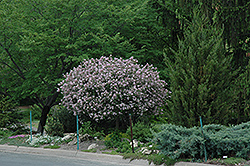


| Phone: |
| 613-599-3419 |
| Email: |
| info@makeitgreen.ca | Location: |
| 5200 Flewellyn Rd. Stittsville, Ontario
Need Directions? Click for map |
Welcome to our plant search tool. This database contains many of the thousands of plants that we carry. There are some notable exceptions. Hundreds of new perennials come out every year and Make It Green has been a leader in making them available to you. Eventually the recent introductions will make it to our plant search tool but every year there will be a lag between our in-store plant selection and this search tool. Unfortunately this search tool can't cover everything that we will carry this year. We also carry over 100 varieties of rare and unusual evergreens and over 100 varieties of hard-to-find shrubs many of which are not in the plant search. Click on the Plant List button for a list of nearly all the woody plants (trees, shrubs and evergreens) that we have ordered or already have in stock for this coming year.
Dwarf Korean Lilac (tree form)*
Syringa meyeri 'Palibin (tree form)'
* This is a "special order" plant - contact store for details
Height: 7 feet
Spread: 4 feet
Sunlight:
![]()
Hardiness Zone: 3a
Description:
A beautiful and popular patio shrub with numerous attributes; striking spikes of fragrant lilac-pink flowers in late spring, small rounded foliage and a uniform compact ball shape grafted onto a standard, best used as a solitary accent in the garden
Ornamental Features
Dwarf Korean Lilac (tree form) is smothered in stunning panicles of fragrant lilac purple flowers at the ends of the branches in late spring, which emerge from distinctive violet flower buds. The flowers are excellent for cutting. It has dark green deciduous foliage which emerges burgundy in spring. The small pointy leaves do not develop any appreciable fall colour.
Landscape Attributes
Dwarf Korean Lilac (tree form) is a dense deciduous tree, selected and trained to grow in a small tree-like form with the primary plant grafted high atop a standard. Its relatively fine texture sets it apart from other landscape plants with less refined foliage.
This is a relatively low maintenance tree, and should only be pruned after flowering to avoid removing any of the current season's flowers. It is a good choice for attracting butterflies to your yard. It has no significant negative characteristics.
Dwarf Korean Lilac (tree form) is recommended for the following landscape applications;
- Accent
- General Garden Use
- Container Planting
Planting & Growing
Dwarf Korean Lilac (tree form) will grow to be about 7 feet tall at maturity, with a spread of 4 feet. It tends to be a little leggy, with a typical clearance of 3 feet from the ground, and is suitable for planting under power lines. It grows at a slow rate, and under ideal conditions can be expected to live for approximately 30 years.
This tree should only be grown in full sunlight. It is very adaptable to both dry and moist locations, and should do just fine under average home landscape conditions. It is not particular as to soil type or pH. It is highly tolerant of urban pollution and will even thrive in inner city environments. This is a selected variety of a species not originally from North America.
Dwarf Korean Lilac (tree form) is a fine choice for the yard, but it is also a good selection for planting in outdoor pots and containers. With its upright habit of growth, it is best suited for use as a 'thriller' in the 'spiller-thriller-filler' container combination; plant it near the center of the pot, surrounded by smaller plants and those that spill over the edges. It is even sizeable enough that it can be grown alone in a suitable container. Note that when grown in a container, it may not perform exactly as indicated on the tag - this is to be expected. Also note that when growing plants in outdoor containers and baskets, they may require more frequent waterings than they would in the yard or garden. Be aware that in our climate, most plants cannot be expected to survive the winter if left in containers outdoors, and this plant is no exception. Contact our experts for more information on how to protect it over the winter months.
* This is a "special order" plant - contact store for details


